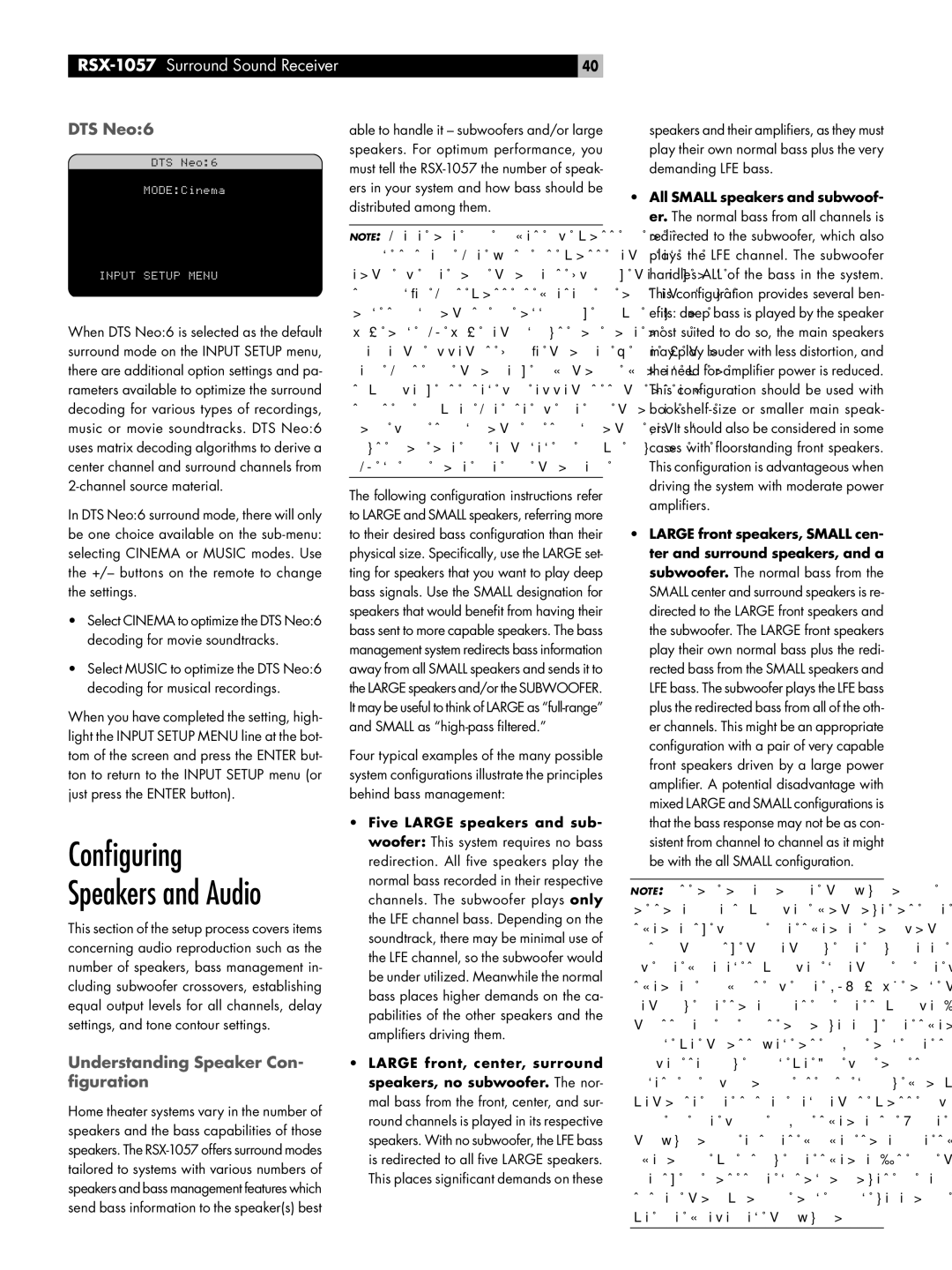RSX-1057Surround Sound Receiver
DTS Neo:6
DTS Neo:6
MODE:Cinema
INPUT SETUP MENU
When DTS Neo:6 is selected as the default surround mode on the INPUT SETUP menu, there are additional option settings and pa- rameters available to optimize the surround decoding for various types of recordings, music or movie soundtracks. DTS Neo:6 uses matrix decoding algorithms to derive a center channel and surround channels from 2-channel source material.
In DTS Neo:6 surround mode, there will only be one choice available on the sub-menu: selecting CINEMA or MUSIC modes. Use the +/– buttons on the remote to change the settings.
•Select CINEMA to optimize the DTS Neo:6 decoding for movie soundtracks.
•Select MUSIC to optimize the DTS Neo:6 decoding for musical recordings.
When you have completed the setting, high- light the INPUT SETUP MENU line at the bot- tom of the screen and press the ENTER but- ton to return to the INPUT SETUP menu (or just press the ENTER button).
Configuring
Speakers and Audio
This section of the setup process covers items concerning audio reproduction such as the number of speakers, bass management in- cluding subwoofer crossovers, establishing equal output levels for all channels, delay settings, and tone contour settings.
Understanding Speaker Con- figuration
Home theater systems vary in the number of speakers and the bass capabilities of those speakers. The RSX-1057 offers surround modes tailored to systems with various numbers of speakers and bass management features which send bass information to the speaker(s) best
40
able to handle it – subwoofers and/or large speakers. For optimum performance, you must tell the RSX-1057 the number of speak- ers in your system and how bass should be distributed among them.
NOTE: There are two types of bass in a sur- round system. The first is bass recorded in each of the main channels (front, center, and surround). This bass is present in all recordings and soundtracks. In addition, Dolby Digital
5.1and DTS 5.1 recordings may have a Low Frequency Effects (LFE) channel – the .1 chan- nel. This LFE channel, typically played by a subwoofer, is used for effects such as explo- sions or rumble. The use of the LFE channel will vary from soundtrack to soundtrack. Record- ings that are not encoded in Dolby Digital or DTS do not have the LFE channel.
The following configuration instructions refer to LARGE and SMALL speakers, referring more to their desired bass configuration than their physical size. Specifically, use the LARGE set- ting for speakers that you want to play deep bass signals. Use the SMALL designation for speakers that would benefit from having their bass sent to more capable speakers. The bass management system redirects bass information away from all SMALL speakers and sends it to the LARGE speakers and/or the SUBWOOFER. It may be useful to think of LARGE as “full-range” and SMALL as “high-pass filtered.”
Four typical examples of the many possible system configurations illustrate the principles behind bass management:
•Five LARGE speakers and sub- woofer: This system requires no bass redirection. All five speakers play the normal bass recorded in their respective channels. The subwoofer plays only the LFE channel bass. Depending on the soundtrack, there may be minimal use of the LFE channel, so the subwoofer would be under utilized. Meanwhile the normal bass places higher demands on the ca- pabilities of the other speakers and the amplifiers driving them.
•LARGE front, center, surround speakers, no subwoofer. The nor- mal bass from the front, center, and sur- round channels is played in its respective speakers. With no subwoofer, the LFE bass is redirected to all five LARGE speakers. This places significant demands on these
speakers and their amplifiers, as they must play their own normal bass plus the very demanding LFE bass.
•All SMALL speakers and subwoof- er. The normal bass from all channels is redirected to the subwoofer, which also plays the LFE channel. The subwoofer handles ALL of the bass in the system. This configuration provides several ben- efits: deep bass is played by the speaker most suited to do so, the main speakers may play louder with less distortion, and the need for amplifier power is reduced. This configuration should be used with bookshelf-size or smaller main speak- ers. It should also be considered in some cases with floorstanding front speakers. This configuration is advantageous when driving the system with moderate power amplifiers.
•LARGE front speakers, SMALL cen- ter and surround speakers, and a subwoofer. The normal bass from the SMALL center and surround speakers is re- directed to the LARGE front speakers and the subwoofer. The LARGE front speakers play their own normal bass plus the redi- rected bass from the SMALL speakers and LFE bass. The subwoofer plays the LFE bass plus the redirected bass from all of the oth- er channels. This might be an appropriate configuration with a pair of very capable front speakers driven by a large power amplifier. A potential disadvantage with mixed LARGE and SMALL configurations is that the bass response may not be as con- sistent from channel to channel as it might be with the all SMALL configuration.
NOTE: As an alternative configuration with a satellite/subwoofer package as the front speakers, follow the speaker manufacturer’s instructions, connecting the high-level inputs of the powered subwoofer directly to the front speaker outputs of the RSX-1057 and con- necting the satellites to the subwoofer’s own crossover. In this arrangement, the speakers would be classified as LARGE and the sub- woofer setting would be OFF for all surround modes. No information is lost during playback because the system redirects bass informa- tion to the front LARGE speakers. While this configuration ensures proper satellite speaker operation by using the speaker’s own cross- overs, it has some disadvantages in terms of system calibration and would generally not be the preferred configuration.

